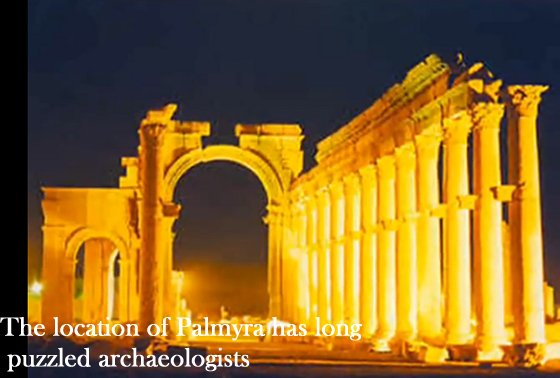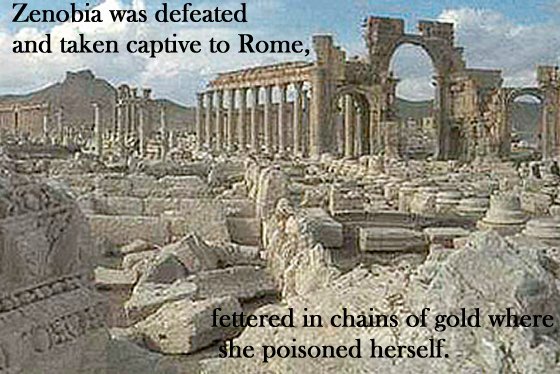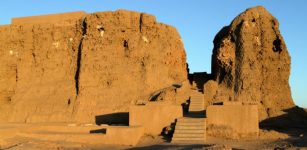Magnificent Ancient City Of Palmyra In Danger: Isis Reached Gates Of The City
MessageToEagle.com – Isis reached gates of ancient Syrian city Palmyra and seized control Thursday of buildings in the outskirts of the ancient city of Palmyra, report world news agencies.
“If (ISIL) enters Palmyra, it will spell its destruction,” Syria’s antiquities director Maamoun Abdulkarim said.
Will the ancient Palmyra be destroyed in the same way as Nimrud, Hatra and Mosul?
Palmyra’s ancient ruins are located 150 miles (243 km) north-east of Damascus, Syria. However, current political situation makes a visit to Palmyra (also known as Tadmor) impossible.
Why was Palmyra located in the desert? And how was it possible for a large number of people to live in such a hostile place nearly 2000 years ago?
Ancient silk-road city of Palmyra was once a part of the vast Roman Empire and one of the richest cities in the Near East. Great stone ruins and the columns of temples and public buildings now rise among the remote sandy wastes. Once, the great city flourished.
The power and independence the city attained from its connections with other Nabatean epicentres of commerce such as Petra. The transfer of goods and knowledge flowed along the Silk Road from the depths of Asia Minor to the Mediterranean ports of ancient times.
The origins of Palmyra are still very obscure. However, according to some sources, the city dates back to the times of King Solomon.
But how about the city’s name?
Is its name associated with the date palms of the region?
Until the third century AD, Palmyra with 100,000 inhabitants, was a flourishing and important trade center. The city’s traders traveled throughout the world-famous Roman Empire bringing home spices and silkspices from China and India.

A warrior queen called Zenobia ruled the ancient city of Palmyra, “the place of palms” as the Romans called it. Zenobia rebelled against the Romans and captured lands as far to the west as Egypt and also in Asia Minor to the north.
In 1089 AD Palmyra, which had its amazing rise and later, a tragic fall, was totally destroyed by an earthquake and with time buried under the desert sands.
It was built in the middle of the Syrian desert, at a considerable distance from any other water source, as it is 150 km from the Orontes River in the west and 200 km from the Euphrates in the east.
The location of Palmyra has puzzled a group of archaeologists from Bergen, Norway.
After four years of research conducted with their Syrian colleagues, they could finally solve the riddle of Palmyra.

“These findings provide a wealth of new insight into Palmyra’s history,” says project manager Jørgen Christian Meyer, a professor at the University of Bergen.
The Bergen-based archaeologists to make an unusual approach to the problem. Instead of examining the city itself, they studied an enormous expanse of land just to the north of Palmyra ruins.
Along with their Syrian colleagues from the Palmyra Museum and aided by satellite photos, they catalogued a large number of ancient remains visible on the Earth’s surface.

“In this way, we were able to form a more complete picture of what occurred within the larger area,” Professor Meyer explained.
The team detected a number of forgotten villages from ancient Roman times, equipped in water reservoirs utilised by the ancients on a daily basis.
In fact, the scientists were not studying a desert, but rather an arid steppe, with underground grass roots that keep rain from sinking into the soil.
The Palmyrians were able to conduct efficient soil cultivation almost 2,000 years ago.

Ancient silk-road city of Palmyra was once a part of the vast Roman Empire and one of the richest cities in the Near East. Great stone ruins and the columns of temples and public buildings now rise among the remote sandy wastes. Once, the great city flourished.
The power and independence the city attained from its connections with other Nabatean epicentres of commerce such as Petra. The transfer of goods and knowledge flowed along the Silk Road from the depths of Asia Minor to the Mediterranean ports of ancient times.
The origins of Palmyra are still very obscure. However, according to some sources, the city dates back to the times of King Solomon.
But how about the city’s name?
Is its name associated with the date palms of the region?
Until the third century AD, Palmyra with 100,000 inhabitants, was a flourishing and important trade center. The city’s traders traveled throughout the world-famous Roman Empire bringing home spices and silkspices from China and India.
A warrior queen called Zenobia ruled the ancient city of Palmyra, “the place of palms” as the Romans called it. Zenobia rebelled against the Romans and captured lands as far to the west as Egypt and also in Asia Minor to the north.
In 1089 AD Palmyra, which had its amazing rise and later, a tragic fall, was totally destroyed by an earthquake and with time buried under the desert sands.
It was built in the middle of the Syrian desert, at a considerable distance from any other water source, as it is 150 km from the Orontes River in the west and 200 km from the Euphrates in the east.
The location of Palmyra has puzzled a group of archaeologists from Bergen, Norway.
After four years of research conducted with their Syrian colleagues, they could finally solve the riddle of Palmyra.
“These findings provide a wealth of new insight into Palmyra’s history,” says project manager Jørgen Christian Meyer, a professor at the University of Bergen.
The Bergen-based archaeologists to make an unusual approach to the problem. Instead of examining the city itself, they studied an enormous expanse of land just to the north of Palmyra ruins.
Along with their Syrian colleagues from the Palmyra Museum and aided by satellite photos, they catalogued a large number of ancient remains visible on the Earth’s surface.
“In this way, we were able to form a more complete picture of what occurred within the larger area,” Professor Meyer explained.
The team detected a number of forgotten villages from ancient Roman times, equipped in water reservoirs utilised by the ancients on a daily basis.
In fact, the scientists were not studying a desert, but rather an arid steppe, with underground grass roots that keep rain from sinking into the soil. The Palmyrians were able to conduct efficient soil cultivation almost 2 000 years ago.
Technological inventions were definitely not beyond comprehension of the ancients.
Ancient flourishing Palmyra and the nearby villages collected the rainwater using dams and cisterns. This gave the surrounding villages water for crops and enabled them to provide the city with food; the collection system ensured a stable supply of agricultural products and averted catastrophe during droughts.
Palmyra’s location also had a political foundation. Important east-west trade routes, including along the Euphrates River to the north, were not under the control of the Romans to the west or the Persians to the east. Local lords and chieftains demanded high fees for passage.
This practice of extortion translated into a tremendous opportunity for the Palmyrians; they joined forces with the Bedouins to provide security, beasts of burden and guides through the desert.
“Tradesmen from Palmyra made the most of the city’s unique location to build up a comprehensive trade network,” says the professor.
In the 2nd century A.D. Palmyra traded all the way to China and Italy.
The Romans conquered Palmyra in the first century AD, but despite its conquered status, the city – which became one of the great cities of the orient – could still maintain a relative degree of freedom that slowly increased with time.
In the third century AD, the situation changed. The most famous ruler of Palmyra was the warrior queen Zenobia, dressed in purple with a helmet on her head. She was an ambitious and very brave queen with a strong personality.
She loved history and philosophy. She spoke several languages, like Greek and Egyptian and Aramaic was her native language.
She even claimed to be a descendant of Queen Cleopatra.
When Zenobia proclaimed herself queen, she declared her independence from Rome.
The Romans attacked Palmyra and laid siege to the fortified city of Palmyra. The queen Zenobia was defeated and taken captive to Rome, fettered in chains of gold where she poisoned herself.
Palmyra’s fall became reality.
Copyright © MessageToEagle.com All rights reserved. This material may not be published, broadcast, rewritten or redistributed in whole or part without the express written permission of MessageToEagle.com












